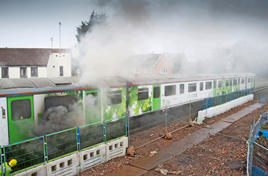“We want to show two things: that a pure battery train can run on short branch lines while recharging at a terminus station, and that a battery/EMU hybrid could charge up and then run beyond the wires, which could be relevant on some routes where Network Rail is distinctly unenthusiastic about electrification. There’s also another advantage that a route could be partially electrified, to avoid the cost where bridges might need raising or track needs lowering.
“Between now and July, we will run this demonstrator in a variety of ways to assess its range, acceleration, braking and lots of other performance characteristics. In July, we will then replace the original DC traction motors with new AC traction motors, so we can complete EMC testing.”
The battery-powered demonstrator is a little more utilitarian than 230001, which has been fully fitted out with accessible toilets, information screens, CCTV, LED lighting and a variety of seating configurations to demonstrate both the modular choices available to customers and its compliance with 2020 PRM-TSI (Persons of Reduced Mobility - Technical Specifications for Interoperability) regulations.
The demonstrator has not been refurbished or deep cleaned yet, and so still resembles its former life as a driving car on London Underground’s District Line with all its original interior fittings still intact. It also has three engine modules rather than the two that will be carried by the finished production version, which will be available to customers either as a two-car or three-car unit with driving cars at either end. That’s because a diesel engine has been retained on the demonstrator to simulate the electrical supply needed to test it as an EMU/battery hybrid, on Long Marston’s unelectrified test track.
The diesel engine is also powering the air compressor which is needed for the brakes, and which will eventually be replaced by an electric compressor. The battery modules are also charged for the time being by the extra diesel engine, although that too will be reconfigured to take its charge from a mains supply.
This leaves two battery modules, one beneath the train and one within the saloon.
The battery-powered D-Train variant does not yet have a class number, unlike the Class 230 DEMU prototype, but will gain one once testing is complete and approvals have been granted during the summer.
“I haven’t got an answer yet for what class the battery train will be,” adds Shooter. “The rolling stock library will either specify that, or give us a choice when we finish testing.”
A technician with a laptop is on board the train, monitoring its performance and capturing key data on power consumption, how long the batteries take to recharge, and how much regenerative energy is being returned to the batteries from the vehicle’s braking system.
Shooter says all this information will be vital when speaking to customers, to enable more accurate business cases to be drawn up for deploying battery trains on specific routes. He adds that the technician is also keeping a close eye on acceleration rates, because it is so rapid when powering a single car around Long Marston’s 3km test track.
The single-car battery train using just two modules can apparently more than match the acceleration of the four-engine DEMU prototype, and so acceleration has had to be artificially limited so as not to exceed the test track’s 40mph speed limit, and to protect the underframe equipment.
Shooter says: “In the next few months we will be gathering data that we can apply to customers’ individual cases with conviction, and we’ve already had some customers on the train whose feedback has been generally very good. There has been a lot of interest in this as no one has previously had the opportunity to buy a battery train, but soon they will.”
Although Shooter is unable to provide details of firm orders, or of interested parties for any of the D-Train variants (for confidentiality reasons), there is already ample evidence that Vivarail is gearing up to begin full production of D-Trains later in the year.
















Login to comment
Comments
No comments have been made yet.